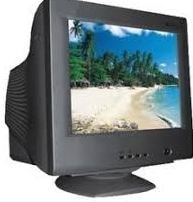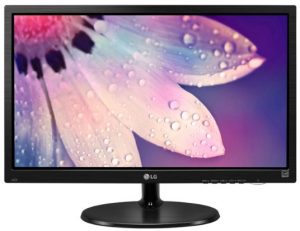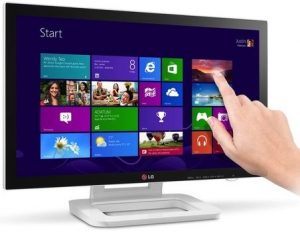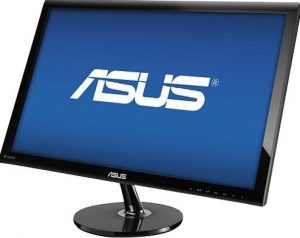4 Types of Monitors with their functions
Table of Contents
A monitor is an important output device. All results of processing are shown on the monitor screen. To learn more about monitors, their types, the difference between various types of monitors, functions, and features are the core points discussed in this article. Let,s read it.
Monitor or Visual Display Unit
The monitor is the most important and commonly used output device. The result of the processing displayed by the monitor is called output. A monitor looks the same as a television. It is used to display images, text, videos, etc.
Read Also: Types of Secondary Memory

 Monitor uses the cathode ray tube (CRT) technology. CRT tube uses an electron beam to generate an image on the screen. CRT is based on one or more guns that fire a beam of electrons within the screen. Very tiny phosphor dots are used to coat the screen from inside.
Monitor uses the cathode ray tube (CRT) technology. CRT tube uses an electron beam to generate an image on the screen. CRT is based on one or more guns that fire a beam of electrons within the screen. Very tiny phosphor dots are used to coat the screen from inside.
Electrons beam frequently falls on the surface of the screen. Every beam fall occurs in just a fraction of a second. In color monitors, CRT consists of three guns. These guns generate red, green, blue (RGB) colors. The other colors are generated with the combination of these three colors.
Features of Monitors
- Size
- Resolution
- Refresh rate
- Dot pitch
Size
Monitors are available in different sizes. The standard monitor for personal computers is 13 to 16 inches. The size of the monitor is measured diagonally.
Resolution
The resolution of a monitor is the number of pixels on the screen. It is the image sharpness of a display screen. It is expressed as a matrix. A resolution of 640×480 means there is 640 horizontal pixels and 480 vertical pixels. The actual resolution is determined by the video controller, not by the monitor. Most monitors provide resolutions of 640×480, 800×600, and 1024×768.
Refresh Rate
The number of times the electron guns scan every pixel on the screen in one second is called refresh rate. It is measured in Hertz (Hz) or cycles per second.
Dot Pitch
The distance between the phosphorus dots that create a single pixel is called a dot pitch.
Video Display Adapters
A display screen must have a video display adapter attached to the computer to display graphics. It is also called a video graphics card. It is a circuit board that determines the following things:
- Resolution
- Number of colors
- The speed with which images appear on the display screen
Types of Graphic Cards
There are three types of graphics cards:
VGA
VGA stands for video graphics array. It supports 16-256 colors depending on screen resolution. It supports 15 colors at 320×200 pixels. VGA also supports 256 colors at 640×840 pixels. It is called 4-bit color.
SVGA
SVGA stands for super video graphics array. It supports 256 colors at high resolution than VGA. It has two graphics modes. these are 800×600 pixels and 1024×768. SVGA is also called 8-bit color. SVGA is the most common standard used today.
XGA
XGA stands for extended graphics array. It supports up to 16.7 million colors at a resolution of 1024×768 pixels. XGA supports 256, 65536, or 16,777,216 colors depending on the video display adapter memory chip. It is called 24-bit color or true color. XGA provides the most sophisticated standard for color and resolution.
Touch Screen Monitors

Touch screen monitors permit input as well as output. A touch screen is a special type of VDU (Visual display unit). It has a grid of light beams or fine wires on the screen. It lets used the user interacts with a computer with the touch of a finger rather than typing on a keyboard or moving a mouse.
Icons or menus present on the screen allow a user to enter data by touching on these icons or menus. Generally, computers with touchscreen use sensors to detect the touch of a finger.
Monochrome and Color Monitors

Monochrome means one color. Color or monochrome monitors display images in a single color usually white, green, blue, red, or amber. The monochrome monitor can, however, display shades of one color.
Monochrome monitors are mostly used for simple words processing and other applications, which do not require colors and graphics. Color monitors display output in different colors. Graphics, pictures, and colorful images are best viewed in color monitors.
Flat Panel or LCD Monitors
Laptop PCs use flat-panel monitors. These monitors take less space. Flat-panel monitors use a variety of technologies. The most common LCD (Liquid crystal display). LCD monitors use much less power than a normal monitor.

LCD monitors create images with a special type of liquid crystal that is normally transparent but becomes solid when charged with electricity. These monitors are passive matrix and active matrix.
Active matrix monitors have higher refresh rates and better contrast with a more brilliant display. Color monitors need three transistors for each pixel: one for red, green, and blue. Active matrix LCD displays are more expensive than a passive matrix. Active matrix LCD displays are usually used in high-end notebook PCs.
Advantages of Flat Panel Display Over CRT
The advantages of flat panel display over CRT are as follows:
- It is more expensive than a CRT monitor
- Takes less desk space
- Consume less energy than a CRT monitor
- Based on liquid crystal technology
- Less weight than CRT
- Mostly used in notebook computers, PDAs, cellular phones, and personal computers
- Safe from emitting harmful radiation
Difference Between CRT and LCD
| CRT | LCD monitor |
| It is less expensive than an LCD monitor | It is more expensive than a CRT monitor |
| Takes more desk space | Takes less desk space |
| More energy is used than an LCD monitor | Less energy is used than the CRT monitor |
| Based on picture tube technology | Based on liquid crystal technology |
| More weight than LCD | Less weight than CRT |
| Personal computers use CRT monitors | LCD monitors are used by Notebook computers, PDAs, cellular phones, and personal computers. |
| It emits harmful radiation | It does not emit harmful radiation |
Difference Between Active and Passive Flat Panel Display
| Active Flat Panel | Passive Flat Panel |
| In the active flat panel, its own transistor controls each pixel on the screen. | In the passive flat panel, its own transistor controls the complete row or column of pixels |
| Active matrix screen is much brighter and sharper than passive-matrix screen | Passive matrix screen gives a sharp image for one color but subdued for more colors |
| Active matrix screens are more complicated and expensive. | Passive matrix screens are less complicated and expensive |
| It consumes more power | It consumes less power |
| 4 Types of Communication Devices | 5 Generations of Computer | 2 Forms of Computer Memory |


